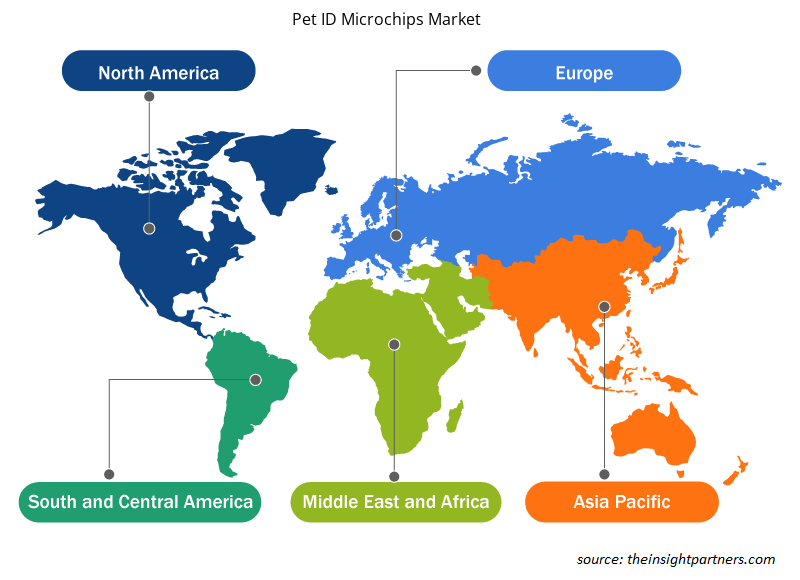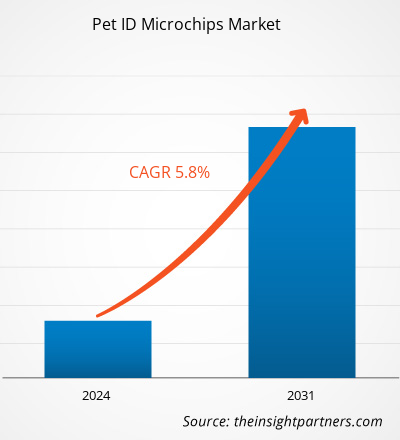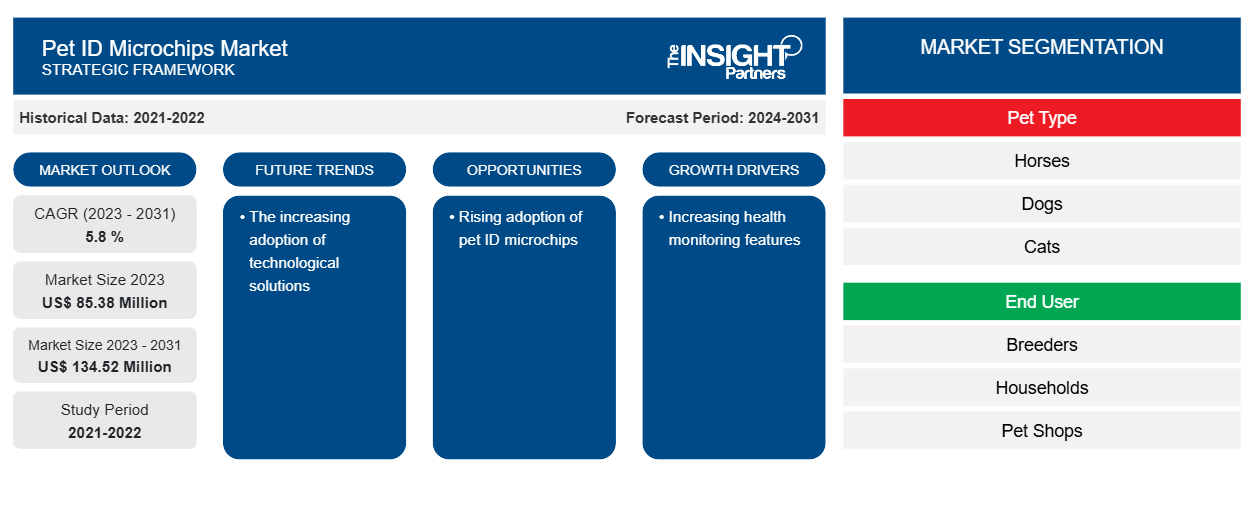Der Markt für Mikrochips zur Haustieridentifizierung soll von 85,38 Millionen US-Dollar im Jahr 2023 auf 134,52 Millionen US-Dollar im Jahr 2031 anwachsen. Der Markt soll zwischen 2023 und 2031 eine durchschnittliche jährliche Wachstumsrate von 5,8 % verzeichnen. Die zunehmende Einführung technologischer Lösungen dürfte ein wichtiger Trend auf dem Markt bleiben.
Marktanalyse für Haustier-ID-Mikrochips
Ein einzelner Chip bleibt bis zu 25 Jahre funktionsfähig und hält ein Leben lang. Die meisten aktuellen Chips arbeiten mit 134,2 kHz, in den USA sind jedoch noch einige 125-kHz-Mikrochips erhältlich. Darüber hinaus wurde die Größe des Mikrochips erheblich reduziert und die Temperaturanzeige des Haustiers beim Scannen mit einem Mikrochip-Scanner verbessert. Mikrochips sind eine effektive Methode zur Identifizierung von Haustieren, da sie im Körper eingebettet sind und daher nicht abgekaut, entfernt, zerrissen oder gefälscht werden können. Tierärzte und Tierschutzorganisationen auf der ganzen Welt begrüßen die gesetzlich vorgeschriebene Mikrochip-Kennzeichnung von Haustieren.
Marktübersicht für Haustier-ID-Mikrochips
Ein Mikrochip ist ein winziges elektronisches Gerät, das alle relevanten Informationen enthält. Auf diesem Chip befindet sich eine Nummer, mit der das Haustier genau identifiziert werden kann. Um einen Chip zu erhalten, müssen Besitzer einen Tierarzt aufsuchen, der ihn ihrem Haustier knapp unter die Haut spritzt. Der Eingriff ist schmerzhaft, daher ist keine Anästhesie erforderlich. Auf dem Mikrochip befindet sich eine Registrierungsnummer des Tierregisters. Bei Bedarf kann ein Scanner die Registrierungsinformationen des Haustiers abrufen. Mikrochips sind ideal für eine dauerhafte, manipulationssichere Identifizierung, aber kein Ersatz für ein Halsband mit aktuellen Identifikationsetiketten.
Passen Sie diesen Bericht Ihren Anforderungen an
Sie erhalten kostenlos individuelle Anpassungen an jedem Bericht, einschließlich Teilen dieses Berichts oder einer Analyse auf Länderebene, eines Excel-Datenpakets sowie tolle Angebote und Rabatte für Start-ups und Universitäten.
-
Holen Sie sich die wichtigsten Markttrends aus diesem Bericht.Dieses KOSTENLOSE Beispiel umfasst eine Datenanalyse von Markttrends bis hin zu Schätzungen und Prognosen.
Markttreiber und Chancen für Mikrochips zur Haustieridentifikation
Steigende Verbreitung von Mikrochips zur Haustieridentifizierung
Verschiedene Spezialisten für Haustier-IDs bieten Haustier-ID-Mikrochips für Kunden aus allen Bereichen des Tierschutzes an, darunter Rettungsdienste, Veterinärmedizin, Hundefriseur, lokale Behörden, Züchter, Tierdienste und Zoos. Darüber hinaus bieten Haustier-ID-Anbieter in verschiedenen Regionen, wie Großbritannien und anderen, Projekte zum Schutz der Tierwelt an. So brachte MSD Animal Health im Oktober 2022 den HomeAgain Thermochip auf den Markt, einen neuen Identifikations-Mikrochip, der einen Temperatur-Biosensor enthält, der die subkutane Temperatur der Katze oder des Hundes misst. Daher treibt die zunehmende Verbreitung von Haustier-ID-Mikrochips den Markt für Haustier-ID-Mikrochips an.
Erweiterte Funktionen zur Gesundheitsüberwachung
Tragbare Accessoires sind wesentliche Elemente intelligenter Gesundheitsüberwachungssysteme für Haustiere. Sie erfassen mithilfe von Sensoren, die in Halsbänder oder Geschirre eingebettet sind, verschiedene Gesundheitsinformationen und liefern wertvolle Informationen zur Gesundheit Ihres Haustiers. Geräte wie FitBark oder Whistle werden am Halsband des Haustiers befestigt und überwachen körperliche Aktivität, Schlafmuster und Kalorienverbrauch. Sie liefern Informationen über die Fitness und das Energieniveau des Haustiers. Die Marken Tractive und Link AKC bieten GPS-fähige Halsbänder an, mit denen Sie den Standort Ihres Haustiers jederzeit verfolgen können. Dies ist besonders nützlich für Haustiere, die sich im Freien aufhalten oder zum Herumstreunen neigen. Die zunehmenden Gesundheitsüberwachungsfunktionen schaffen also mehr Möglichkeiten für den Markt.
Marktbericht zu Mikrochips für Haustier-IDs – Segmentierungsanalyse
Wichtige Segmente, die zur Ableitung der Marktanalyse für Haustier-ID-Mikrochips beigetragen haben, sind Haustierart und Endbenutzer.
- Basierend auf der Komponente ist der Markt für Mikrochips für Haustier-IDs in Pferde, Hunde, Katzen und andere unterteilt. Das Segment Pferde hatte im Jahr 2023 einen größeren Marktanteil.
- Nach Endverbraucher ist der Markt in Züchter, Haushalte, Zoohandlungen und Sonstige segmentiert.
Marktanteilsanalyse für Haustier-ID-Mikrochips nach geografischer Lage
Der geografische Umfang des Marktberichts für Haustier-ID-Mikrochips ist hauptsächlich in fünf Regionen unterteilt: Nordamerika, Asien-Pazifik, Europa, Naher Osten und Afrika sowie Süd- und Mittelamerika.
Nordamerika dominiert den Markt für Mikrochips zur Identifizierung von Haustieren. Laut der American Pet Products Association (APPA) werden die Menschen in den USA im Jahr 2022 etwa 109,6 Milliarden US-Dollar für ihre Haustiere ausgeben. Darüber hinaus werden Haustierzubehörteile immer fortschrittlicher und es gibt eine wachsende Zahl von Erfindungen und Entwicklungen in der Haustierbranche. Daher steigt die Nachfrage nach Mikrochips für Haustiere in der Region.
Regionale Einblicke in den Markt für Haustier-ID-Mikrochips
Die regionalen Trends und Faktoren, die den Markt für Mikrochips für Haustier-IDs im Prognosezeitraum beeinflussen, wurden von den Analysten von Insight Partners ausführlich erläutert. In diesem Abschnitt werden auch die Marktsegmente und die Geografie für Mikrochips für Haustier-IDs in Nordamerika, Europa, im asiatisch-pazifischen Raum, im Nahen Osten und Afrika sowie in Süd- und Mittelamerika erörtert.

- Erhalten Sie regionale Daten zum Markt für Haustier-ID-Mikrochips
Umfang des Marktberichts zu Mikrochips für Haustier-IDs
| Berichtsattribut | Details |
|---|---|
| Marktgröße im Jahr 2023 | 85,38 Millionen US-Dollar |
| Marktgröße bis 2031 | 134,52 Millionen US-Dollar |
| Globale CAGR (2023 - 2031) | 5,8 % |
| Historische Daten | 2021-2022 |
| Prognosezeitraum | 2024–2031 |
| Abgedeckte Segmente |
Nach Haustierart
|
| Abgedeckte Regionen und Länder |
Nordamerika
|
| Marktführer und wichtige Unternehmensprofile |
|
Marktteilnehmerdichte für Haustier-ID-Mikrochips: Auswirkungen auf die Geschäftsdynamik verstehen
Der Markt für Mikrochips zur Haustieridentifizierung wächst rasant. Dies wird durch die steigende Nachfrage der Endnutzer aufgrund von Faktoren wie sich entwickelnden Verbraucherpräferenzen, technologischen Fortschritten und einem größeren Bewusstsein für die Vorteile des Produkts vorangetrieben. Mit der steigenden Nachfrage erweitern Unternehmen ihr Angebot, entwickeln Innovationen, um die Bedürfnisse der Verbraucher zu erfüllen, und nutzen neue Trends, was das Marktwachstum weiter ankurbelt.
Die Marktteilnehmerdichte bezieht sich auf die Verteilung der Firmen oder Unternehmen, die in einem bestimmten Markt oder einer bestimmten Branche tätig sind. Sie gibt an, wie viele Wettbewerber (Marktteilnehmer) in einem bestimmten Marktraum im Verhältnis zu seiner Größe oder seinem gesamten Marktwert präsent sind.
Die wichtigsten auf dem Markt für Haustier-ID-Mikrochips tätigen Unternehmen sind:
- Pethealth Inc
- Merck & Co. Inc
- Elanco Tiergesundheit Inc.
- Avid Identification Systems Inc
- Datamars SA
- Trovan GmbH
Haftungsausschluss : Die oben aufgeführten Unternehmen sind nicht in einer bestimmten Reihenfolge aufgeführt.

- Überblick über die wichtigsten Akteure auf dem Markt für Haustier-ID-Mikrochips
Marktnachrichten und aktuelle Entwicklungen zu Mikrochips für Haustier-IDs
Der Markt für Mikrochips zur Haustieridentifikation wird durch die Erhebung qualitativer und quantitativer Daten nach Primär- und Sekundärforschung bewertet, die wichtige Unternehmensveröffentlichungen, Verbandsdaten und Datenbanken umfasst. Nachfolgend sind einige der Entwicklungen auf dem Markt für Mikrochips zur Haustieridentifikation aufgeführt:
- PetPace ™, ein führendes Unternehmen im Bereich der fortschrittlichen Gesundheitsüberwachung von Haustieren, gab die Markteinführung von PetPace 2.0 bekannt, einem KI-gestützten, lebensrettenden intelligenten Hundehalsband, das kontinuierliche, nahezu in Echtzeit medizinische Erkenntnisse zur Früherkennung, Behandlung, Überwachung und GPS-Verfolgung der Gesundheit von Hunden liefert. PetPace verbessert die Gesundheit und Lebensqualität von Haustieren durch Fernüberwachung, um Tierbesitzern ein beruhigendes Gefühl zu geben. (Quelle: PetPace, Pressemitteilung, Mai 2024.)
- International Alliance Technologies will am 26. April sein Vorzeigeprodukt auf den Markt bringen, eine Haustier-ID-Marke mit QR-Code. Die Marke ist mit einer Informationsdatenbank verbunden, die nach Aktivierung kostenlos genutzt werden kann. Die Datenbank enthält geschützte persönliche Informationen wie die Adresse und Telefonnummer des Besitzers, Krankenakten, Kontaktdaten des Tierarztes und mehr und bietet außerdem Zugang zu einem rund um die Uhr verfügbaren Kundenservice. (Quelle: International Alliance Technologies, Pressemitteilung, April 2021)
Marktbericht zu Mikrochips für Haustier-IDs – Umfang und Ergebnisse
Der Bericht „Marktgröße und Prognose für Haustier-ID-Mikrochips (2021–2031)“ bietet eine detaillierte Analyse des Marktes, die die folgenden Bereiche abdeckt:
- Marktgröße und Prognose für Pet ID-Mikrochips auf globaler, regionaler und Länderebene für alle wichtigen Marktsegmente, die im Rahmen des Projekts abgedeckt sind
- Markttrends für Mikrochips zur Haustieridentifikation sowie Marktdynamik wie Treiber, Einschränkungen und wichtige Chancen
- Detaillierte PEST/Porters Five Forces- und SWOT-Analyse
- Marktanalyse für Haustier-ID-Mikrochips mit wichtigen Markttrends, globalen und regionalen Rahmenbedingungen, wichtigen Akteuren, Vorschriften und aktuellen Marktentwicklungen
- Branchenlandschaft und Wettbewerbsanalyse mit Marktkonzentration, Heatmap-Analyse, prominenten Akteuren und aktuellen Entwicklungen auf dem Markt für Haustier-ID-Mikrochips
- Detaillierte Firmenprofile
- Historische Analyse (2 Jahre), Basisjahr, Prognose (7 Jahre) mit CAGR
- PEST- und SWOT-Analyse
- Marktgröße Wert/Volumen – Global, Regional, Land
- Branchen- und Wettbewerbslandschaft
- Excel-Datensatz
Aktuelle Berichte
Verwandte Berichte
Erfahrungsberichte
Grund zum Kauf
- Fundierte Entscheidungsfindung
- Marktdynamik verstehen
- Wettbewerbsanalyse
- Kundeneinblicke
- Marktprognosen
- Risikominimierung
- Strategische Planung
- Investitionsbegründung
- Identifizierung neuer Märkte
- Verbesserung von Marketingstrategien
- Steigerung der Betriebseffizienz
- Anpassung an regulatorische Trends























 Kostenlose Probe anfordern für - Markt für Haustier-ID-Mikrochips
Kostenlose Probe anfordern für - Markt für Haustier-ID-Mikrochips